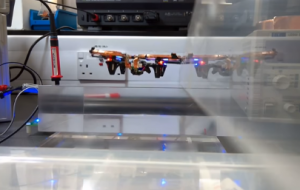Imperial College London scientists have made use of a highly efficient method called ‘inductive coupling’ to wirelessly transfer power to an airborne drone.
The use of small drones for commercial purposes, in surveillance, for reconnaissance missions, and search and rescue operations are rapidly growing.
However, the distance that a drone can travel and the duration it can stay in the air is limited by the availability of power and re-charging requirements.
Wireless power transfer technology could certainly solve this, say the Imperial College team. Their breakthrough allows a drone to stay in flight indefinitely by simply hovering over a ground support ‘recharge’ vehicle.
Inductive coupling was initially demonstrated by inventor Nikola Tesla over 100 years ago. It involves two copper coils electronically tuned into one another which in turn enables the wireless exchange of power at a certain frequency. Scientists have been experimenting with this technology for decades, but have not been able to wirelessly power flying technology.
Now scientists from Imperial College London have removed the battery from an off-the-shelf mini-drone and demonstrated that they can wirelessly transfer power to it via inductive coupling.
To demonstrate their approach the researchers bought an off-the-shelf quadcopter drone, around 12 centimetres in diameter, and altered its electronics and removed its battery. They made a copper foil ring, which is a receiving antennae that encircles the drone’s casing. On the ground, a transmitter device made out of a circuit board is connected to electronics and a power source, creating a magnetic field.
The drone’s electronics are tuned or calibrated at the frequency of the magnetic field. When it flies into the magnetic field an alternating current (AC) voltage is induced in the receiving antenna and the drone’s electronics convert it efficiently into a direct current (DC) voltage to power it.
The technology is still in its experimental stage. Nevertheless, once commercialized the researchers believe their breakthrough could have a range of advantages in the development of commercial drone technology and other devices.
Wirelessly transferring power could have also applications in other areas such as sensors, healthcare devices and further afield, on interplanetary missions.
Professor Paul Mitcheson, from the Department of Electrical and Electronic Engineering at Imperial College London, explains: “Imagine using a drone to wirelessly transmit power to sensors on things such as bridges to monitor their structural integrity. This would cut out humans having to reach these difficult to access places to re-charge them.
“In the future, we may also be able to use drones to re-charge science equipment on Mars, increasing the lifetime of these billion-dollar missions.”




